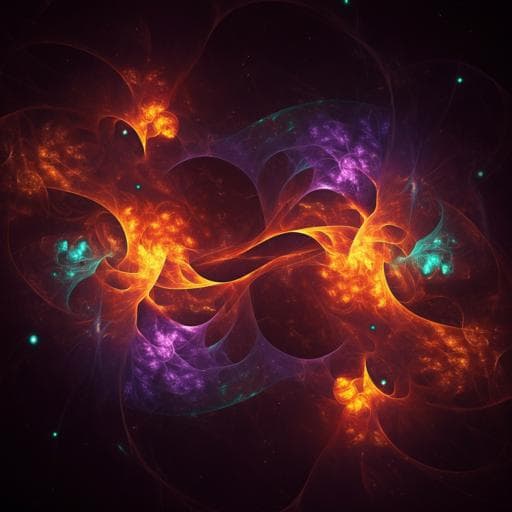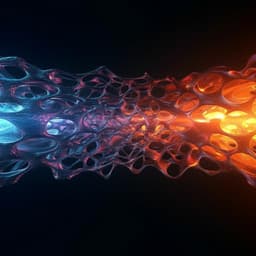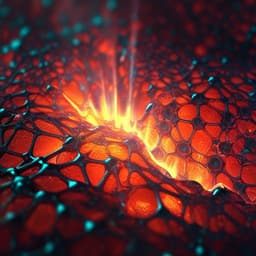
Physics
Photoexcitation induced magnetic phase transition and spin dynamics in antiferromagnetic MnPS<sub>3</sub> monolayer
Y. Gao, X. Jiang, et al.
Discover the groundbreaking research by Yinlu Gao, Xue Jiang, Zhiyong Qiu, and Jijun Zhao, which explores the photoinduced spin dynamics in MnPS3 monolayers. Their findings reveal a light-triggered phase transition from antiferromagnetic to ferromagnetic, significant for future spintronic applications and optical information storage.
~3 min • Beginner • English
Introduction
The study addresses how ultrafast optical excitation controls magnetic order and spin dynamics in two-dimensional antiferromagnets, focusing on MnPS3 monolayer. While numerous 2D ferromagnets have shown optically driven changes in magnetization and anisotropy, optically controlling antiferromagnetic (AFM) order remains less explored. The purpose is to determine whether optical (photo) doping can induce an AFM-to-ferromagnetic (FM) phase transition in MnPS3 and to elucidate the microscopic spin-relaxation pathways responsible for this transition. The work is important for advancing ultrafast, non-contact spin control in low-power spintronics, quantum technologies, and optically tunable magnetic devices.
Literature Review
Prior work demonstrated optical control of magnetism in various 2D ferromagnets and ferrimagnets: ultrafast all-optical switching via optically induced intersite spin transfer in ferrimagnetic MXenes; stabilization of FM phase by optical doping in monolayer RuCl3; laser-induced modulation of magnetic anisotropy and domain formation in CrI3; tunable magnetization and Curie temperature in few-layer Fe3GeTe2. However, the spin dynamics and optically driven phase control in 2D antiferromagnets are less studied. MnPS3 is an experimentally realized AFM semiconductor with intriguing optoelectronic behavior, motivating the present investigation into its photoinduced magnetic phase transition and spin dynamics.
Methodology
- Density functional theory (DFT): VASP with PAW pseudopotentials; PBE generalized gradient approximation with Hubbard U = 5 eV on Mn (Dudarev scheme); plane-wave cutoff 500 eV. A vacuum spacing of 15 Å along out-of-plane direction. Structures relaxed to forces < 0.001 eV/Å and energy < 1e-5 eV. Brillouin zone sampling with k-point grids of 2π × 0.02 Å−1.
- Magnetic configurations and exchange coupling: Energetics of FM, Néel AFM, zigzag AFM, and stripy AFM computed (2 × 1 × 1 supercell). Exchange parameters J1, J2, J3 obtained by mapping total energies to a Heisenberg Hamiltonian H = −∑_{i≠j} J_ij S_i·S_j.
- Simulation of photoexcited carriers (optical doping): Occupations manually adjusted to introduce electron-hole (e–h) pairs by removing electrons near the valence-band edge and adding them to the conduction band, enabling control of e–h pair density.
- Spin dynamics: Time-domain ab initio nonadiabatic molecular dynamics (NAMD) using the SOC-included Hefei-NAMD code, based on fewest-switches surface hopping (FSSH) combined with time-dependent DFT. Spin-diabatic representation with both electron-phonon coupling (EPC; nonadiabatic coupling) and SOC as off-diagonal terms in the time-dependent Schrödinger equation. Decoherence-induced surface hopping (DISH) used to model e–h recombination.
- MD preparation and sampling: Ab initio molecular dynamics pre-run with velocity rescaling to 300 K; 2 ps microcanonical trajectory with 1 fs time step. 2000 structures extracted and 150 initial configurations randomly selected; 5000 NAMD trajectories sampled per initial structure. Initial/final electronic states chosen near CBM and VBM.
- Temperature rise estimation: Lattice specific heat modeled as a combination of Debye and Einstein contributions with parameters x = 0.67, θ_D = 177 K, θ_E = 422 K. Using computed internal energy change (~0.24 eV for the model system mass), the temperature increase during photoexcitation was estimated at ~35 K, below the magnetic ordering temperature (~78 K).
Key Findings
- Ground state and magnetic energetics: Néel AFM is the ground state. FM is higher by ~94.7 meV per formula unit (f.u.). Mn2+ ions are high-spin with on-site moment ~4.61 μB.
- Exchange couplings in pristine MnPS3 monolayer: J1 = −0.35 meV, J2 = −0.06 meV, J3 = −0.12 meV (AFM), with J1 dominating due to strong direct AFM exchange; super-superexchange pathways contribute to J2 and J3.
- Unipolar doping thresholds for AFM→FM transition: electrons ~1.07 × 10^14 cm−2; holes ~1.52 × 10^13 cm−2.
- Optical e–h doping (bipolar): Critical density for AFM-to-FM transition is 1.11 × 10^14 cm−2 (≈0.75 e–h per unit cell). With increasing e–h density, J1, J2, J3 change from negative to positive, consistent with FM stabilization.
- Electronic structure changes under optical doping: Photoexcitation creates localized mid-gap states mainly of S px/py character; conduction-band edge shifts inward; band gap narrows from 2.34 eV to 1.40 eV. Additional S–p and Mn–d hybridization (1–1.5 eV range) induces ~0.16 μB magnetic moment on S atoms. Lattice responds with increased Mn–Mn distances and decreased Mn–S distances, reducing direct AFM exchange and favoring FM superexchange.
- Mechanism: Mid-gap S-p states lower excitation energy and enhance p–d SOC and d–p–d FM superexchange, overcoming direct AFM exchange at sufficient carrier density.
- Spin dynamics and relaxation: EPC dominates p–p relaxation, driving S–p electrons from conduction band to S–p mid-gap states without spin flip. SOC dominates p–d coupling, enabling spin-flip transfer from spin-up S–p to spin-down Mn–d states where recombination occurs. The spin-flip/recombination dynamics yield a photogenerated FM phase lifetime of ~648 fs.
- Thermal considerations: Estimated photoinduced temperature rise ~35 K, below the AFM ordering temperature (~78 K), supporting stability of the photoinduced FM phase during the process.
- Implications: Extended carrier lifetimes due to SOC/EPC interplay suggest MnPS3’s potential in spintronics and as a light-driven photocatalyst/photovoltaic material.
Discussion
The study demonstrates that optical excitation at experimentally accessible carrier densities can reversibly switch MnPS3 from a Néel AFM ground state to a FM phase. This directly addresses the question of whether 2D antiferromagnets can be optically controlled on ultrafast timescales. The key mechanism is the formation of S-p mid-gap states that (i) reduce the Mn–d to S–p energy separation, (ii) enhance p–d SOC and d–p–d FM superexchange, and (iii) diminish the direct AFM exchange through lattice responses (elongated Mn–Mn distances and strengthened Mn–S bonding). NAMD simulations clarify the competing roles of EPC and SOC: EPC governs p–p relaxation to mid-gap states without spin flip, while SOC enables efficient spin-flip p–d transitions, completing recombination and establishing an FM order with a lifetime on the order of hundreds of femtoseconds (~648 fs). The modest temperature rise relative to the ordering temperature supports the magnetic transition being primarily electronic rather than purely thermal. These results expand the paradigm of ultrafast optical control from ferromagnets to antiferromagnets, indicating opportunities for non-contact information storage, spin logic, and optoelectronic or photocatalytic devices where prolonged carrier lifetimes and spin selectivity are advantageous.
Conclusion
The work reveals that MnPS3 monolayer, intrinsically a Néel AFM, undergoes an optically induced AFM-to-FM phase transition at an e–h pair density of ~1.11 × 10^14 cm−2. Optical doping produces S-p mid-gap states that narrow the band gap (2.34 → 1.40 eV), enhance p–d SOC and FM superexchange, and weaken direct AFM exchange, collectively stabilizing FM order. Time-domain NAMD shows EPC-driven p–p relaxation followed by SOC-enabled p–d spin-flip and recombination, yielding a long-lived (~648 fs) FM phase and extended carrier lifetimes. These insights offer a route to ultrafast optical control of AFM semiconductors and suggest MnPS3 as a promising platform for spintronic, photovoltaic, and photocatalytic applications. Potential future work includes experimental verification via time-resolved magneto-optical probes, quantitative control of carrier density and pulse parameters, exploration of temperature and substrate effects, and extension to other AFM semiconductors to generalize the mechanism.
Limitations
- The simulations treat SOC as a perturbation within the spin-diabatic representation; the absolute magnitude of SOC is small in this system.
- The decrease of photoexcited carrier density during interband relaxation is acknowledged but not explicitly included in estimating the FM phase lifetime, potentially overestimating its duration.
- Temperature rise is estimated using Debye–Einstein specific heat models and a computed internal energy change; this provides an approximate ΔT and does not include full electron–phonon nonequilibrium dynamics.
- DFT with PBE+U may not capture all correlation and excitonic effects; occupations were manually adjusted to mimic photodoping, which is an approximation to real photoexcited states.
- Finite-size supercell and sampling choices may influence calculated exchange parameters and dynamical timescales.
Related Publications
Explore these studies to deepen your understanding of the subject.







